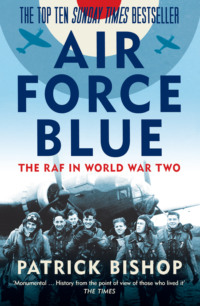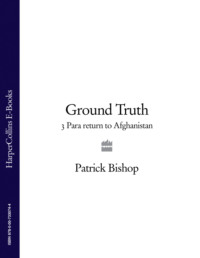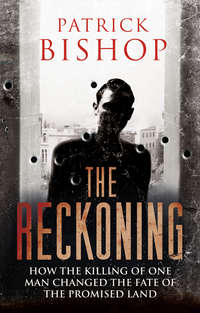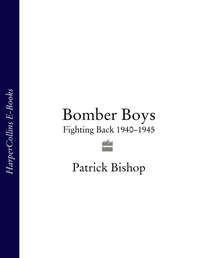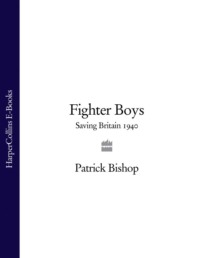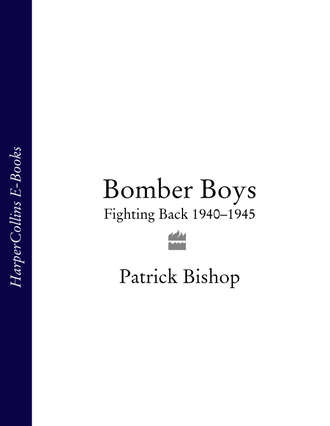
Bomber Boys: Fighting Back 1940–1945
At the end of specialist training everyone was promoted. The majority, about two thirds, became sergeants. The rest were commissioned as pilot officers. The criteria used to award commissions were vague. The logic that leaders were automatically officers was not always followed. The captain of a bomber was the pilot, and it seemed sensible that the captain should hold the senior rank. But it was not unusual for a sergeant pilot to be outranked by his navigator or bomb-aimer. Operating a heavy bomber involved shared responsibility and intense mutual dependence. The anomalies and injustices of drawing distinctions of status, as well as pay and conditions, between men who fought and died inside the same claustrophobic metal tube grated particularly on the Canadians who were providing so many men.
The matter surfaced in May 1942 at an air training conference in Ottawa. It seemed to the Royal Canadian Air Force that there was ‘no justification for the commissioning of some individuals whilst others are required to perform exactly the same duties but in NCO rank.’ The Canadians pointed out the inequities of pay, transportation and travel allowances. Dividing crews into commissioned and non-commissioned officers meant, in theory at least, the end of socializing on an equal footing. Sergeants would go to the sergeants’ mess, officers to the better-appointed officers’ mess. They argued that it could only be bad for team spirit if ‘the crew, as an entity is not able to live and fraternize, the one with the other, during leisure and off-duty hours.’ A radical solution was proposed. Everyone flying in a bomber should be an officer.
The RAF avoided answering the Canadians’ detailed points, but did try to define the qualities that made an officer. Commissions were granted, ‘in recognition of character, intelligence (as distinct from academic qualifications), and capacity to lead, command and set a worthy example. Many aircrews (sic), although quite capable of performing their duties adequately, have no officer qualities.’ The debate fizzled out.
Despite the relative absence of awkwardness about class in the RAF, there was plenty of evidence to suggest that being educated at a public school was no handicap when it came to obtaining a commission. Arriving at Brize Norton Flying Training School in April 1941 Brian Frow and his fellow-trainees were addressed by the chief ground instructor, a squadron leader aged about fifty, with First World War medals on his chest. After a welcoming speech he told his charges he was going to select flight commanders and deputies from among the cadets who would act as leaders and principal contacts between students and staff.
‘We were all sitting in the hall and he started. “Stand up all of those who were in the OTC (Officer Training Corps) at a public school.” About twenty stood up. “Any of you who failed to pass Cert A, sit down.” This left some ten standing. “Sit down those who failed to reach the rank of corporal.” Two more sat down. “Failed to reach sergeant.” Three more sat down. (He) then said, “You five airmen report to my office for interview.”’
When Frow arrived, ‘The first question was “Do you have any close relations who were commissioned in the Royal Air Force?” I had two brothers, and when I said that one was a squadron leader … that was sufficient.’ He was ‘amused and somewhat embarrassed by this method of selecting the cadet flight commanders and their deputies … By a process of elimination, he had dismissed all cadets who had not attended public school, who had not been in the OTC, who had failed to pass Cert A and who had no close relations commissioned into the RAF.’ Frow was duly appointed commander of ‘A’ Flight.
At the same time as they were graded by rank, the cadets earned the right to wear the brevet appropriate to their aircrew category. To outsiders there seemed something unformed about the single wing and circle insignia. It prompted an article by Godfrey Winn, a star writer of the day. ‘Don’t ask the man with one wing when he will finish his training and get the other half of his wings,’ he advised. ‘Don’t ask him anything. Just shake his hand and offer him a drink.’
Aircrew members were proud of their trades. Many had started out hoping to be pilots. Few of those who were reassigned resented for long the new roles they had been allotted. It was the crew that mattered more than one’s individual part in it.
Flying a big bomber was entirely different from flying a Spitfire or a Hurricane. It was the difference, it was sometimes said, between a sports car and a lorry. A four-engined bomber was an immensely complex machine, whose systems needed constant checking. It was a responsibility rather than a pleasure. Tony Iveson who flew Lancasters with 617 Squadron believed that bomber pilots needed ‘a steady personality, and you could tell that from what you heard about how they behaved off duty … I was a natural bomber pilot. I was patient. I liked precise flying.’13
Fighter pilots wrote about flying in the language of love and passion. There are no descriptions in letters and memoirs of the joy of flying a Halifax or a Lancaster. In fighter squadrons it was considered disrespectful to refer to your aircraft as anything other than an aeroplane. Bomber Boys called theirs ‘kites’. Operational flying over Germany could mean trips of seven, eight, nine hours. These journeys involved high drama at take-off and landing and intense fear over the target area. But between these peaks of feeling there were long passages of boredom and fatigue, especially on the journey home, even though the danger was far from over.
Crews were organic entities and the prevailing atmosphere was egalitarian. Nonetheless, there was no doubt that it was the pilot who ultimately was in charge. He was responsible for the lives of the other six members of the crew, to the extent that if the aircraft was irretrievably damaged or on fire and about to explode he was expected to stay at the controls until the others had baled out.
The pilot, together with the navigator and the bomb-aimer, were essential for a bomber to be be able to bomb. It was extremely desirable to have a flight engineer, wireless operator and mid-upper and rear gunners. But a sortie could succeed without them.
The pilot’s concern was to reach the target. The navigator’s job was to find it. Don Charlwood, a navigator himself, felt that ‘as a group [they] tended more to seriousness than the men they flew with’.14 The job, and the training it required, were demanding and exhausting. Noble Frankland, like many navigators, had started off wanting to be a pilot but failed to make the grade. Despite his high intelligence he found the course at his elementary navigation school ‘academically the most difficult thing I had ever tackled’. Astronavigation required an ability to think in three dimensions, ‘a very, very difficult concept for somebody who is not mathematically gifted or trained’.15 In the early days navigators had no radio aids to guide them to targets. Even with the advent of Gee, Oboe and H2S, which used radio and radar pulses to direct aircraft on to targets, the navigator’s job was the most mentally testing of aircrew tasks, requiring constant alertness at every stage of the journey.
Once the navigator had guided the aircraft to the target area the bomb-aimer took over. As the aircraft went into its bombing run, he became the most important person aboard. He lay face-down in the Perspex nose, exposing the length of his body to the flak bursting all around. Pressing his face to the lens of the complicated bombsight, he called course corrections to the pilot as they went into the final run, ordered the bomb doors open and, when he was satisfied, pressed the button that sent the bombs tumbling into the night. In those final moments, every man aboard was clenched in expectation, pleading with him to finish the job and let them head for home. Good bomb-aimers possessed an almost inhuman sangfroid which allowed them to divorce all feelings for their own safety and that of the crew from the necessity of getting their bombs on the target, or the colour-coded pyrotechnic markers dropped by the leading aircraft to highlight the aiming point. On his debut trip with 49 Squadron to Hagen, in the eastern Ruhr, Donald Falgate, who had defied his parents’ wishes to join up, was ‘determined I was going to get my bombs slap-bang on the target and there was no way I was going to release them if I couldn’t get the markers in the bombsight.’
The pilot weaved to avoid the bursting flak as they went in, toppling the gyroscope that kept the bombsight level, making it impossible for Falgate to aim accurately. He ordered the bomb doors closed and insisted on going round again. ‘I won’t repeat what was said over the intercom by various crew members,’ he said when telling the story later. It was only on the third run that Falgate was satisfied and pressed the bomb release. ‘I was unpopular, very unpopular,’ he recalled many years afterwards.16
The complexities of four-engined bombers created a need for an extra crew member to assist the pilot. Many flight engineers were ex-groundcrew airmen who already had mechanical skills. Their training included a spell at an aircraft factory producing the type of bomber they would fly in to ensure that they were fluent in all the systems of the huge new machines. In a Lancaster they sat next to, and slightly behind the captain. Their duties included monitoring the panels of dials and warning lights, one for each engine, which were situated on the side of the fuselage out of the pilot’s line of sight. This left him to concentrate on his flying instruments. Their most important responsibility was nursing the fuel levels to ensure there was enough petrol to get home. Engineers received elementary flying training and could theoretically fly the aircraft in an emergency. In practice, if the pilot was dead or too badly hurt to function, the engineer was likely to be in a similar condition.
The wireless operator had, according to Bruce Lewis, who served as one, ‘a lonely existence, mentally isolated from other members of the crew for long periods of time while he strained to listen through the static in his headphones for faint but vital signals.’ These told him the aircraft’s position which he passed on to the navigator. He also manned the radar monitor which warned of the approach of night-fighters.
The gunners had what appeared to be the worst job of all. They lived in metal and Perspex turrets that poked out of the top and the back of the aircraft, washed by whistling winds that could freeze them to their guns. They carried the huge responsibility of defending their mates, constantly scanning the night for flak and fighters. Yet the long hours of staring into darkness meant it was all too easy to lose concentration, even fall asleep. If a night-fighter was spotted a decision that could mean the difference between life or death had to be made. You had seen him, but had he seen you? There was one sure way of ensuring he had, which was to pour glowing tracer fire in his direction. If you got it wrong, your end was particularly lurid. Everyone had a story of seeing the rear gunner being hosed out of a shot-up bomber that had hobbled back to base.
Yet some chose the job. It was the quickest way to an operational squadron with the actual gunnery course taking only six weeks. The training, though, was thorough. By the end, many could manipulate the turrets so well they could trace their names on a board with a pencil wedged in a gun barrel. Cyril March had seen an RAF recruiting poster in the window of Stanton’s furniture store in his native Durham appealing for Tail End Charlies and ‘decided there and then that I would become an air gunner, none of the other trades appealing to me.’ For all the privations and dangers of the job it was possible to get used to it or even enjoy it. ‘In the end you learned to love it, strangely to say,’ said Edward Twinn, who had abandoned a safe job in a reserved occupation to join up. ‘You were the king of your own castle, right back there on your own. You never spoke to anybody unless the pilot gave you orders, so there you were sixty feet from the rest of the crew, all together at the front of the aircraft. They could see each other, they were near each other and they had that bond of being together. But the rear gunner, no, he was right out on a limb, down the other end looking the other way. Many of the raids lasted seven, eight, eight and a half hours … you never left your turret at all. It was lonely but you got used to it. And you were there for the crew’s protection and they were a lovely crew.’17
After finishing their specialist training pilots, navigators and bomb-aimers had a further spell at an advanced school before finally arriving at an OTU. Wireless operators and gunners went there directly.
At the OTUs the British came together with their Australian and New Zealand counterparts from the Empire schools (the Canadians formed their own, separate group of squadrons). It was here that one of the most crucial processes in the training programme took place, the welding of individuals into crews. For each member, the crew would from now on be the centre of his existence. Life beyond the base, the world of parents and family and home, drifted to the margins of their thoughts. The six men you would share your bomber with were now the most important people in the world.
The process of selection was called ‘crewing up’. In devising it the RAF departed from its strictly utilitarian selection and training methods and took an enormous leap of faith. Instead of attempting a scientific approach to gauge compatibility they put their trust entirely in the magic of human chemistry. The crews selected themselves. The procedure was simple. The requisite numbers of each aircrew category were put together in a large room and told to team up. Jack Currie, who reached his OTU at the end of 1942, ‘hadn’t realized that the crewing-up procedure would be so haphazard, so unorganized. I’d imagined that the process would be just as impersonal as most others that we went through in the RAF. I thought I would just see an order on the noticeboard detailing who was crewed with whom. But what happened was quite different. When we had all paraded in the hangar and the roll had been called, the chief ground instructor got up on a dais. He wished us good morning … and said: “Right chaps, sort yourselves out.”’
Currie stood among the other sergeant pilots and, trying not to stare at anyone in particular, looked around him. ‘There were bomb-aimers, navigators, wireless operators and gunners and I needed one of each to form my crew. I didn’t know any of them; up to now my air force would have been peopled by pilots. This was a crowd of strangers. I had a sudden recollection of standing in a surburban dance-hall, wondering which girl I should approach. I remembered that it wasn’t always the prettiest or the smartest girl who made the best companion for the evening. Anyway, this wasn’t the same as choosing a dancing partner, it was more like picking out a sweetheart or a wife, for better or for worse.’
Like most pilots, the first thing Currie looked for was a navigator. He saw a knot of them standing together. But how was he to pick one?
I couldn’t assess what his aptitude with a map and dividers might be from his face, or his skill with a sextant from the size of his feet. I noticed that a wiry little Australian was looking at me anxiously. He took a few steps forward, eyes puckered in a diffident smile and spoke: ‘Looking for a good navigator?’ I walked to meet him. He was an officer. I looked down into his eyes, and received an impression of honesty, intelligence and nervousness. He said:
‘You needn’t worry. I did all right on the course!’
I held out my hand. ‘Jack Currie.’
‘I’m Jim Cassidy. Have you got a bomb-aimer? I know a real good one. He comes from Brisbane, like me. I’ll fetch him over.’
The bomb-aimer had a gunner in tow and while we were sizing each other up, we were joined by a tall wireless-operator, who introduced himself in a gentle Northumbrian accent and suggested that it was time for a cup of tea. As we walked to the canteen, I realized that I hadn’t made a single conscious choice.18
At some OTUs new arrivals were given up to a fortnight to team up. Harry Yates, having got over his disappointment at not being posted to a fighter squadron, arrived at Westcott with the ambition to ‘skipper a well-drilled crew, the best on the squadron, every man handpicked, utterly professional at his job and dedicated to the team.’ He started his search in the officers’ mess where he found himself at the bar next to Pilot Officer Bill Birnie, a stocky New Zealander navigator who ‘seemed to be the sort of tough-minded chap who knew the score’. During the evening’s socializing he noticed a young pilot officer wearing a wireless operator’s badge. For a wireless operator to be commissioned so early in his career suggested exceptional ability. So Rob Bailey, ‘tall, slim and blessed with the dark, aquiline looks that women tend to admire’, was in.
The following day the 220 men of the intake assembled in a hangar to finish off the process. They were mostly formed into twos and threes now and there was ‘a lot of movement and noise’, as they scrambled to complete their teams. Bill Birnie disappeared into the crowd and returned ‘with a bronze-skinned giant in tow. This was Flight Sergeant Inia Maaka, the first Maori I’d ever met and I knew the bomb-aimer for me.’ Mac, as he immediately became known, ‘was a stranger to the inner tensions and vanities that make liars of the rest of us’. He had wanted to fight the war as a pilot and had won a place at elementary flying school but had not been selected to advance and been reassigned to bombing school. ‘He clearly loved the job,’ Yates recorded, ‘there wasn’t a hint of second best.’ It was Mac who found the gunners: Geoff Fallowfield, an extrovert eighteen-year-old Londoner and Norrie Close, a taciturn Yorkshireman, who was a month younger still. ‘So there they were,’ Yates marvelled later, ‘my crew: a straight and level Kiwi, a ladykiller; a Maori warrior; and two lads as different as chalk from cheese.’19
Such assorted crews were the norm. The mysterious chemistry that had brought them together was durable. Many crews forged bonds of affection and respect that, if they came through the war, lasted until the grave. It was rare for an Englishman to have met a Canadian or an Australian, yet when crewing up they seemed drawn to each other, confirming the wisdom of the process. Group Captain Hamish Mahaddie, who was tasked with finding talent for the Pathfinder Force, which was formed to lead the main bomber force to the target, believed that ‘the best crews were a mixture’.20
The system was not perfect. At Bruntingthorpe OTU Cyril March teamed up with an Australian skipper, navigator and wireless operator. The rest of the crew were English. ‘We did our job and had one or two good thrashes but we were never all together and to my mind we didn’t gel.’ Their first training trip was a fighter affiliation exercise in which the pilot was expected to throw the Wellington around the sky to shake off the ‘attacker’. After a row with the navigator, he appeared to lose control and ordered the crew to crash positions. The bomber landed but overshot the runway coming to a halt in the grass. The next trip took place in clear sunshine but the captain still managed to lose his way. March ‘felt so bloody helpless. I was doing my job, telling them when we were passing over airfields and such. I couldn’t help thinking [what] if this were Germany on a black night with duff winds etcetera – Christ!’ Word of the crew’s failings reached the station authorities. It was split up and its members redistributed. This time March was lucky. The first of his new comrades was Ken Ford, a Londoner, who with the rest of the crew, became his lifelong friends.
Ken took me to meet my new skipper, a tousle-haired fair Aussie with steady blue eyes and a friendly grin. ‘I’m Neville Emery,’ he said, ‘Bug to my mates.’ I had noticed he had been eyeing me up and down and asked him why. ‘Oh nothing mate,’ he said laughing. ‘Kenny was telling me that you were an old married man.’ I was just twenty-one. I met Des Gee the Aussie wireless operator, again blond and blue-eyed; then Ray Brooker, a dark Englishman from Cambridge, the bomb-aimer with a ready smile. Then I met Terry Sayles, a Yorkshireman from Doncaster, the navigator. I told him my name was Cyril. ‘Hi Cy,’ he said and that was my name thenceforth. Des got me a bed in their Nissen hut and helped me move my gear in. That night they weren’t flying and they said, ‘Coming down the village for a jar?’ ‘Sure,’ I said.
‘Where’s your bike, Cy?’ Terry asked. ‘Bike!’ I replied, ‘I haven’t got one.’ He got one, I don’t know where and I didn’t ask. Off we went in formation. I knew I was in a crew at long last.
They came back in high spirits, yelling ‘Bring out your dead’ as they wobbled on their bikes over rickety planks bridging the Leicestershire ditches. Cyril was happy and content. ‘I knew then that with these lads we would survive, no doubt about it.’
This, in the end, was what the airmen were searching for as they milled around the hangars looking for kindred spirits. An efficient air, a friendly manner were all very well. But in the end, the most attractive quality anyone could possess was to seem lucky.
Inevitably, when the mating ritual finished, a gaggle of wallflowers remained. ‘At the end of the day there were some odd bods left around who … had no choice but to take the leftovers,’ said Tom Wingham, who flew with 102 Squadron. ‘[You] had a feeling that they weren’t going to make it and inevitably they didn’t. They didn’t have that same sort of “gel”. I suppose you could say they had the smell of death about them and it was not funny.’21
The men that would lead them through the final stage of training and into the daunting world of ‘ops’ seemed old, even though many were only in their mid-twenties. These were the veterans, ‘tour-expired’ survivors of thirty operations or more. ‘It was our first close contact with people who had completed operations, surviving against unlikely odds,’ wrote Dennis Field. ‘Gongs were common, almost part of the dress, and worn without flamboyance. Although we were keen to hear and learn all we could, in off-duty hours they stayed detached and there was little line-shooting in our presence. We realized that within a few months we should all meet some ultimate experience.’
Instructing posts were the reward for survival. Not that such jobs were free of risk. Half of the flying done at OTUs was at night. The darkness, and the sometimes clapped-out machines which were used for training meant that deadly accidents were routine. After agreeing to fly with one captain, Dennis Steiner was approached by two other pilots whom he had to turn down. Subsequently, one flew into the ground for no discoverable reason, killing himself and all his crew. The other developed engine trouble during a flight and ordered the crew to bale out. ‘Their luck ran out soon after when at night a practice bomb from another aircraft fell on them and they crashed,’ he wrote. ‘None of the crew survived. The line between surviving or not was becoming very thin.’
It seemed to Ken Newman that at least some of the accidents were due to criminal recklessness rather than the demands of war. In February 1944 he went to a Heavy Conversion Unit for a month’s training. This was where crews familiarized themselves with the types that they would be flying on operations. Newman was learning his way around the Halifax. ‘The aircraft were old, poorly maintained and in the most part barely airworthy. But it was constantly drilled into us that complaints would not be entertained and if we refused to fly because we thought a Halifax was not airworthy, or for a reason that the staff decided was trivial, we would be treated as LMF [Lacking in Moral Fibre, the RAF bureaucratic euphemism for the accusation of cowardice].’ This was very much the view of the chief flying instructor who Newman held responsible for the death of one of his best friends and all his crew.
He had met Alec, ‘a tall, likeable chap’ while training in South Africa and caught up with him at RAF Lindholme where the HCU was based. One night he was detailed for a high-level cross-country flight, even though the weather forecast had warned of heavy cloud and severe icing conditions. To reduce the risk, it was essential to fly at maximum altitude. ‘Alec took off and after a while found that his aircraft would not climb above 15,000 feet. Consequently he returned to RAF Lindholme. Wing Commander X heard about this and ordered Alec to continue the exercise, refusing to believe that the aircraft could not reach a safe height and accused him of being LMF. Intimidated, Alec and his crew went off. The following day we heard that his aircraft had crashed into a Scottish mountain and all were dead.’ The instructor was to die in an accident a few months later.22




